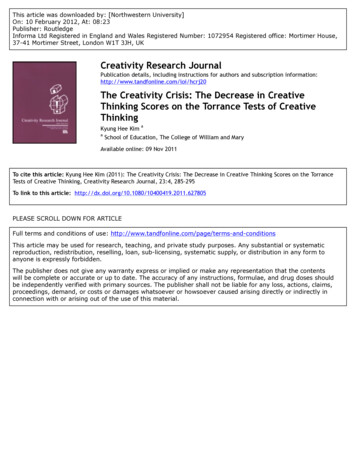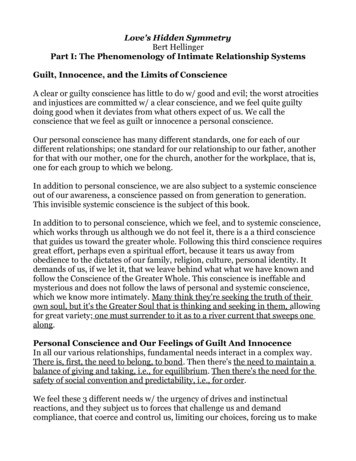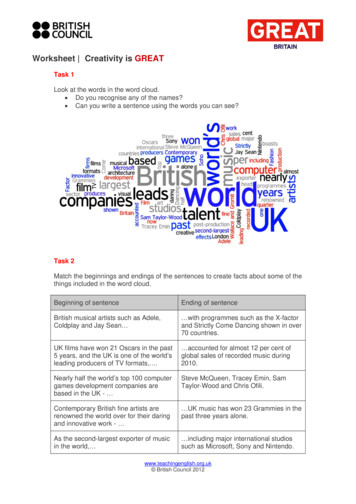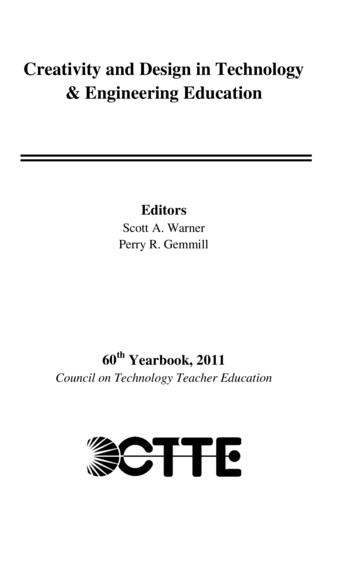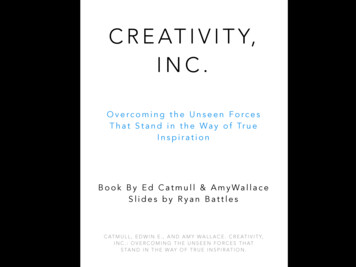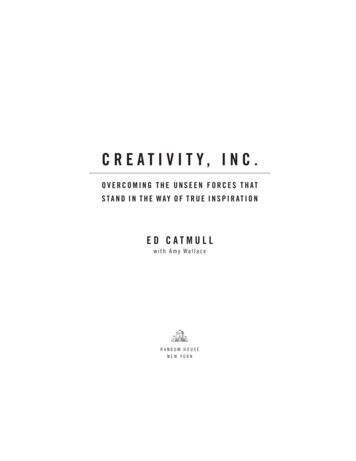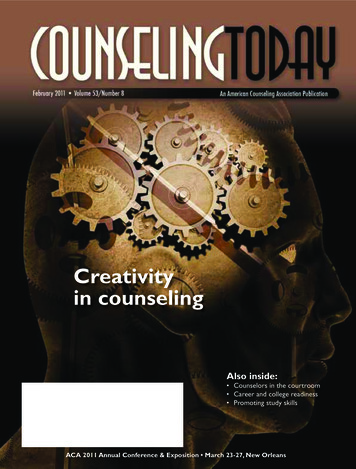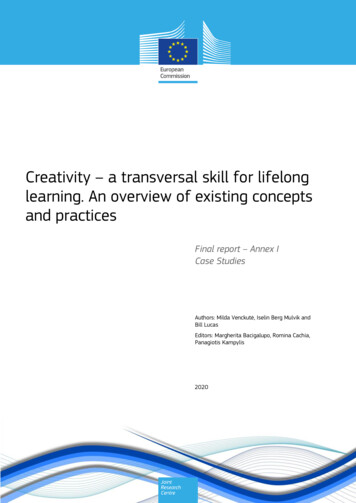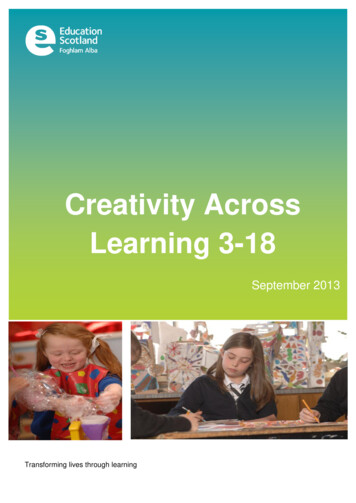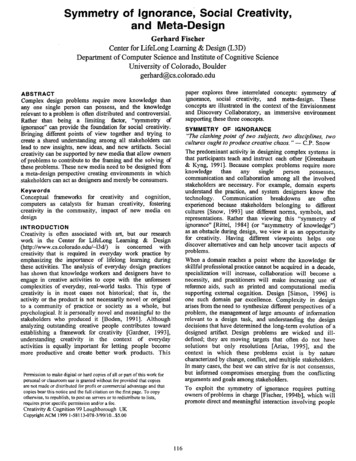
Transcription
Symmetryof Ignorance, Social Creativity,and Meta-DesignGerhardFischerCenter for LifeLong Learning & Design (L3D)Department of Computer Science and Institute of Cognitive ScienceUniversity of Colorado, Bouldergerhard@bs.colorado.edupaper explores three interrelated concepts: symmetry c ignorance, social creativity, and meta-design. Theseconcepts are illustrated in the context of the Envisionmentand Discovery Collaboratory, an immersive environmentsupporting these three concepts.ABSTRACTComplex design problems require more knowledge thanany one single person can possess, and the knowledgerelevant to a problem is often distributed and controversial.Rather than being a limiting factor, “symmetry ofignorance” can provide the foundation for social creativity.Bringing different points of view together and trying tocreate a shared understanding among all stakeholders canlead to new insights, new ideas, and new artifacts. Socialcreativity can be supported by new media that allow ownersof problems to contribute to the framing and the solving ofthese problems. These new media need to be designed froma meta-design perspective creating environments in whichstakeholders can act as designers and merely be consumers.SYMMETRYOF IGNORANCE“The clashing point of two subjects, two disci’h’nes, twocultures ought to produce creative chaos. ” - C.P. SnowThe predominant activity in designing complex systems isthat participants teach and instruct each other [Greenbaum& Kyng, 19911. Because complex problems require moreknowledgethan anysingleperson possesses,communication and collaboration among all the involvedstakeholders are necessary. For example, domain expertsunderstand the practice, and system designers know thetechnology. Communicationbreakdowns are oftenexperienced because stakeholders belonging to differentcultures [Snow, 19931 use different norms, symbols, andrepresentations. Rather than viewing this “symmetry ofignorance” [Rittel, 19841 (or “asymmetry of knowledge”)as an obstacle during design, we view it as an opportunityfor creativity. Having different viewpoints helps onediscover ahematives and can help uncover tacit aspects ofproblems.When a domain reaches a point where the knowledge forskillfil professional practice cannot be acquired in a decade,specialization will increase, collaboration will become anecessity, and practitioners will make increasing use ofreference aids, such as printed and computational mediasupporting external cognition. Design [Simon, 19961 isdne such domain par excellence. Complexity in designarises from the need to synthesize different perspectives of aproblem, the management of large amounts of informationrelevant to a design task, and understanding the designdecisions that have determined the long-term evolution of adesigned artifact. Design problems are wicked and illdefined; they are moving targets that often do not havesolutions but only resolutions [Arias, 19951, and thecontext in which these problems exist is by naturecharacterized by change, conflict, and multiple stakeholders.In many cases, the best we can strive for is not consensus,but informed compromises emerging from the conflictingarguments and goals among stakeholders.To exploit the symmetry of ignorance requires puttingowners ofproblems in charge [Fischer, 1994b], which willpromote direct and meaningful interaction involving peopleKeywordsConceptual frameworks for creativity and cognition,computers as catalysts for human creativity, fosteringcreativity in the community, impact of new media ondesignINTRODUCTIONCreativity is often associated with art, but our researchwork in the Center for LifeLong Learning & Design(http://www.cs.colorado.edu/-13dl)is concerned withcreativity that is required in everyday work practice byemphasizing the importance of lifelong learning duringthese activities. The analysis of everyday design practiceshas shown that knowledge workers and designers have toengage in creative activities to cope with the unforeseencomplexities of everyday, real-world tasks. This type ofcreativity is in inost cases not historical; that is, theactivity or the product is not necessarily novel or originalto a community of practice or society as a whole, butpsychological. It is personally novel and meaningtil to thestakeholders who produced it [Boden, 19911. Althoughanalyzing outstanding creative people contributes towardestablishing a fiamework for creativity [Gardner, 19931,understanding creativity in the context of everydayactivities is equally important for letting people becomemore productive and create better work products. ThisPermission to make digital or hard copies of all or part of this work forpersonal or classroom use is granted without fee provided that copiesare not made or disWiibutedfor protil or commercial advantage and thatcopies bear this notice and the full citation on the first page. To copyotherwise, to republish, to post on servers or to redistribute to lists,requires prior specific permission and/or a fee.Creativity & Cognition 99 Loughborough UKCopyright ACM 1999 l-581 13-078-3/99/10. 5.00116
individual needs is distributed between her/his head and theworld (for example: an address book, a folder system of 6mail messages,a tile system). But a group has no head themfore externalizations are critically more important forsocial creativity. Externalizations (1) create a record of ourmental efforts, one that is “outside us” rather than vaguelyin memory; and (2) represent situations that can talk backto us, critique, and negotiate. To make social creativity areality, we need new forms of knowledge creation,integration, and dissemination. The scarce resource in theinformation age is not information, but human resources toattend to this information [Simon, 19961.in decisions that affect them. In order to bring importantperspectives to the process of design, all stakeholders in theprocess should be designers and co-developers, not justconsumers [Fischer, 1998aJ End-users, as owners ofproblems, bring special perspectives to collaborative designactivities that are of special importance for the framing ofproblems. The “symmetry of ignorance” requires creatingspaces and places that serve as boundary objects wheredifferent cultures can meet. Boundary objects serve asexternalizations that capture distinct domains of humanknowledge and they have, the potential to lead to anincrease in socially shared cognition and practice [Resnicket al., 19911.Accepting that most design problems are characterized by a“symmetry of ignorance” leads to a different view oflearning. In situations for which the knowledge does notexist, it cannot simply be passed on by the people whohave it to the people who need it. Therefore, approaches amrequired that view learning as collaborative knowledgeconstruction [Scardamalia & Bereiter, 19941. This view isin sharp contrast to the teaching cultures of our schools[Illich, 19711, by which teaching is often “fitted into amold in which a single, presumably omniscient teacherexplicitly tells or shows presumably unknowing learnerssomething they presumably know nothing about” pruner,19961. A critical challenge is to reformulate andreconceptualize this impoverished and misleadingconception. Such a teaching culture may be realistic for theearly grades in schools [Hirsch, 19961, but it is obviouslyinadequate for learning processes for which knowledge isdistributed among many stakeholders and “the answer’does not exist or is not known. Historically, the roles OFteacher and learner were associated with a person, whereasin settings characterizedby the “symmetry of ignorance,”being a teacher or being a learner is associated only with aspecific context. “Official” teachers should feel comfortablebecoming learners in many situations.SOCIALKnowledgeCREATIVITYThe power of the unaided, individual mind is highlyoverrated - “the Renaissance scholar does not existanymore”. Much of our intelligence and creativity resultsfrom exploiting the “symmetry of ignorance” as a source ofpower. Although creative individuals are oflen thought of asworking in isolation, the role of interaction andcollaboration with other individuals is critical [Engelbart,19951. Creative activity grows out of the relationshipbetween an individual and the world of his or her work, andout of the ties between an individual and other humanbeings.A GroupCreationOne aspect of supporting organizations and groups increating knowledge is the externalization of an individual’stacit knowledge [Polanyi, 19661. This is important forthree reasons: (1) externalization causes us to begin tomove from vague mental conceptualizations of an idea to amore concrete representation of it; (2) externalizationprovides a means for others to interact with, react to,negotiate around, and build upon it; and (3) externalizationprovides an opportunity to create a common language ofunderstanding. The use of external representations [Pruner,19961 serves to focus discussions upon relevant aspects ofthe framing and understanding of the problem, being studied[Arias et al., 19971 and allows stakeholders to engage in a“conversation with the materials” of the design problem[Schbn, 19831. The ability to interact with the problem athand and to have that situation “talk back” is a crucialmode of design. A principal challenge for social creativityis to capture a significant portion of the knowledgegenerated by work done within a community. Experienceswith organizational memories and collaborative work haveexposed two barriers to capturing information: (1)individuals must perceive a direct benefit in contributing toorganizational memory that is large enough to outweigh theeffort [Grudin, 19891; and (2) the effort required tocontribute to organizational memory must be minimal so itwill not interfere with getting the real work done [Carroll &Rosson, 19871.KnowledgeIntegrationThe challenge is to integrate the various perspectivesemerging from the “symmetry of ignorance“ amongarticulate stakeholders. By supporting the process ofreflection within a shared context defined by the task athand, opportunities can emerge from enhancing the creationof shared understanding. This process melds theinformation that is collaboratively constructed into theproblem-solving context, informing the process as well asthe stakeholders and allowing them to participate fi-om amore enriched and meaningful perspective [Brown et al.,19941. It also enhances the quality of the designed artifactdue to the synergy of interaction that draws out ideas andperspectives in a conversational manner. The resulting,richly contextualized information is available for futurestakeholders to draw upon, informing them, not only aboutthe surface level of the design, but about the deepercharacteristics behindthedesign.Collaborativeconstructions result in work products that are enriched byHas No HeadDistributed cognition [Norman, 19931 emphasizes that theheart of intelligent human performance is not the individualhuman mind but groups of minds in interaction with eachother and minds in interactions with tools and artifacts. Itis important to understand the fundamental diflerence ofdistributed cognition as it operates for the aided individualhuman mind. Distributed cognition between the individualhuman mind and artifacts (such as memory systems) oftenfunctions well, because the required knowledge an117
Figure1: Conceptsdesigners and be creative. This can be compared with theobjective in art that focuses on the artist as the facilitator ofthe creative experience for users. In our work, we haveexplored a set of concepts and ideas for meta-design that aresummarized in Figure 1.We will choose the concept of open, evolvable systems toillustrate some of the aspects and challenges associated withme&design. A fundamental question we have discussed inour research with collaborating communities (such as urbanand transportation planners) has been: “Why do the urbanand transportation planners not take advantage of programssuch as SimCity?” The answer is because SimCity is aclosed system. For example, when users of SimCityencounter a problem with crime in their simulation, there isonly one way to resolve the problem - build more policestations. Other solutions such as increasing social serviceswere not conceived in the model at design time, andbecausethe system is closed, there is no way to explorethese kinds of changes. Although SimCity is a usefuleducational and recreational object, its closed nature is asignificant impediment to using this kind of model foractual city planning. An open system providesopportunities for significant changes to the system at alllevels of complexity, allowing emergent resolution ofsituations in the context of collaborative design.Enhancement and evolution of the system by the owners ofthe problems must be a “first-class design activity.”The need for meta-design is founded on these observations:design problems in the real-world require open systems thatusers can modify and evolve. Because problems cannot becompletely anticipated at design time (when the system isdeveloped), users at use time will discover mismatchesbetween their problems and the support that a systemprovides (see Figure 2).the multiple perspectives of the participants. Theinformation repositories and organizational memories thatare created in these ways are no longer very large,impenetrable “write-only” stores, but are actively integratedinto the work processes and social practices of thecommunity that constructs them.KnowledgeDisseminationHumans seldom (if at all) explore large reflection spaces(e.g., thousands of pages of documentation, designrationales, argumentation, etc.) in the abstract [Moran &Carroll, 19961, but do so to obtain information in responseto breakdowns [Fischer, 1994 1 occurring in their designactivities. Making information relevant to the task at hand(rather than drowningusers in decontextualizedinformation) and supporting the interaction of multipl
skillfil professional practice cannot be acquired in a decade, specialization will increase, collaboration will become a necessity, and practitioners will make increasing use of reference aids, such as printed and computational media supporting external cognition. Design [Simon, 19961 is dne such domain par excellence. Complexity in design
